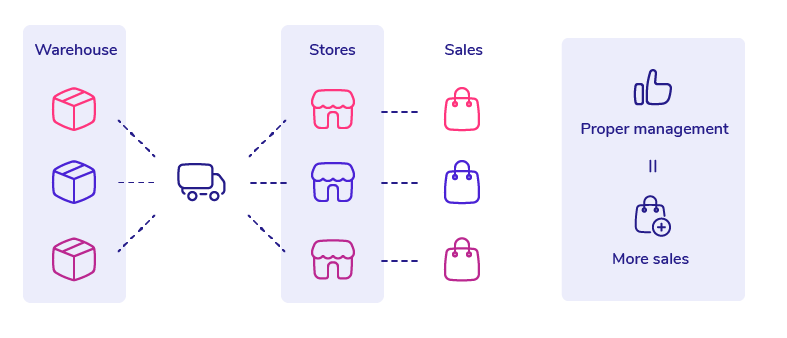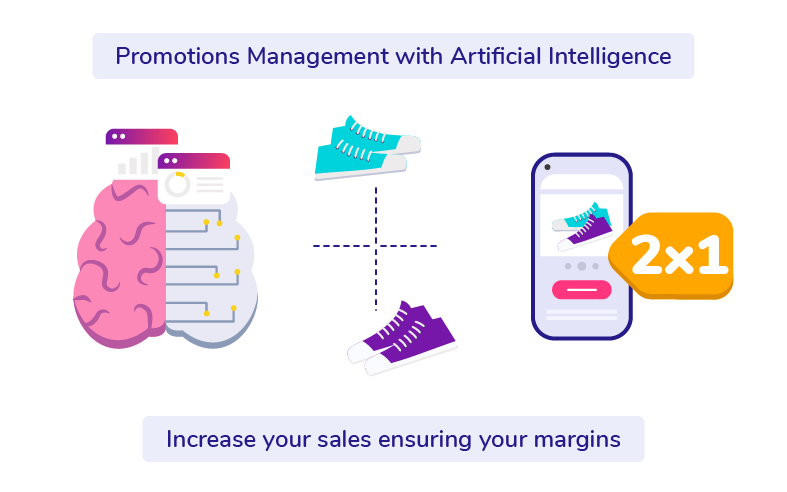Retail clustering or Clusterization (from the English word “cluster: grouping”) is a valuable technique for understanding customers and providing a better shopping experience. There are two main approaches in the retail sector: store-based clusterization and category-based clusterization. Here, we explore why you should clusterize in retail and what types of grouping exist.
Retail clustering based on stores
Store-based clusterization groups stores according to their similar characteristics, such as geographic location, size, and customer demographic profile. This approach allows retailers to tailor their product assortment and marketing strategies to meet the specific needs of each group of stores. However, this approach does not consider that product categories need to be treated differently to target their specific market. We will discuss this further below.
Advantages of Store-Based Retail clustering
Store clustering in the retail sector offers numerous advantages that can enhance efficiency, profitability, and customer satisfaction. Some of the most notable benefits include:
1. Strategic long-term Planning
Store clustering allows retailers to group their stores based on consumer behavior and demographic characteristics. This practice facilitates the generation of insights and forecasts for long-term strategic planning.
2. Assortment Optimization
Store clustering helps retailers also to adapt their product assortments to the specific needs of each store group, which can increase sales and customer satisfaction.
3. Personalization of promotions and pricing
It enables the development of promotion and pricing strategies specific to each store group, which can increase the effectiveness of promotions and improve profitability.
4. Improved space management
Store clustering can help retailers develop more efficient and effective space management strategies, resulting in increased sales and higher average ticket value.
5. More comprehensive analysis
Analyzing and obtaining more precise results on customer behavior can help improve decision-making and product design, and starting from a store structure can be a starting point for your measurement.
6. Adaptability and flexibility
Adapting strategies and approaches based on changes in consumer behavior and market conditions is a MUST in retail. Achieving efficient store grouping will precisely allow you to be more adaptable and flexible.
7. Supply chain efficiency
Store clustering can help retailers optimize their sourcing, storage, and distribution processes, reducing costs and improving supply chain efficiency.
Clusterizing product categories and assortments in Retail
Category-based clusterization is another major grouping technique that we recommend considering, as it groups products according to their similar characteristics, such as product type, price, and demand. This approach allows retailers to tailor their product assortment and marketing strategies to meet the specific needs of each category group. This approach is widely applied by those who prioritize a customer-centric strategy.
Advantages of Category and Assortment Clusterization in Retail
Improved purchasing decisions
Category and assortment clusterization allow retailers to make more informed and efficient purchasing decisions based on the specific needs and preferences of each customer group.
Enhanced shopping experience
By adapting the product assortment and categories to the needs and preferences of each customer group, retailers can offer a more personalized and satisfying shopping experience, which can increase customer loyalty and sales.
Better Inventory Management
Category and assortment clusterization can help retailers manage their inventories more efficiently, reducing the risk of overstocking or stockouts and optimizing inventory turnover.
Profitability optimization by category
Clusterization allows retailers to identify and optimize the profitability of each product category by adjusting the assortment, promotions, and prices based on the needs and preferences of each customer group.
Identification of Growth Opportunities
Another function is that it can help retailers identify growth opportunities in the market. This enables them to adapt their product and service offerings to meet the emerging needs of their customers.
Both techniques are efficient and depend on the overall business strategy, tools, and availability of information to obtain positive results. Implementing this clusterization is essential to succeed in the assortment optimization process and to understand the needs and desires of customers.
In addition to clusterization, retail can benefit from other data analysis techniques, such as price optimization, product management, and customer insights. If you don’t know where to start grouping your points of sale, you can always turn to Artificial Intelligence to clusterize. Not only will you save time and costs, but you will also be able to identify sales opportunities that would have otherwise been difficult to detect.
Retail clustering
Clusterization, the technique of grouping based on certain criteria, is a fundamental tool in the retail industry to enhance customer experiences and streamline operations. This article will delve deeper into how clusterization can be implemented in retail stores and product categories to achieve optimal results.
Enhancing customer experience through store clusterization
Store clusterization focuses on grouping retail stores based on similar characteristics. By understanding these groupings, retailers can fine-tune their operations and offerings to better meet customer needs. This not only improves customer satisfaction but also drives sales.
1. Strategic planning with store clustering
One of the key benefits of store clustering is the ability to engage in strategic long-term planning. By analyzing consumer behavior and demographic data, retailers can forecast trends and plan accordingly. This strategic foresight is crucial for staying ahead in the competitive retail market.
2. Optimizing product assortment
Store clustering allows retailers to customize their product assortment to align with the preferences and demands of each store group. This targeted approach ensures that the right products are available in the right stores, enhancing customer satisfaction and driving sales.
3. Customizing promotions and pricing
Tailoring promotions and pricing strategies to specific store clusters can significantly boost their effectiveness. By understanding the unique characteristics of each store group, retailers can design promotions that resonate with their target audience, leading to increased sales and profitability.
4. Efficient space management
Effective space management is another advantage of store clustering. By understanding the unique needs of each store group, retailers can optimize their store layouts and product placements, leading to improved sales and customer satisfaction.
5. Comprehensive customer behavior analysis
Store clustering enables retailers to conduct more precise and comprehensive analyses of customer behavior. These insights can inform decision-making and product design, ensuring that retailers stay aligned with customer preferences and trends.
6. Adapting to market changes
In the ever-evolving retail landscape, adaptability is key. Store clustering provides the flexibility to adjust strategies based on changes in consumer behavior and market conditions, ensuring that retailers remain competitive and responsive to market dynamics.
7. Enhancing Supply Chain efficiency
Optimizing supply chain processes is another benefit of store clustering. By understanding the unique needs of each store group, retailers can streamline sourcing, storage, and distribution processes, reducing costs and improving overall efficiency.
Product category clustering
While store clustering focuses on the retail locations themselves, category clusterization groups products based on similar characteristics. This approach allows retailers to tailor their product assortment and marketing strategies to meet the specific needs of each product category.
1. Informed purchasing decisions
Category clusterization provides retailers with the insights needed to make more informed purchasing decisions. By understanding the specific needs and preferences of each customer group, retailers can ensure that they are stocking the right products in the right quantities.
2. Personalized shopping experience
Adapting the product assortment to the needs and preferences of each customer group can significantly enhance the shopping experience. This personalized approach not only improves customer satisfaction but also drives loyalty and repeat business.
3. Efficient Inventory Management
Category clusterization also facilitates more efficient inventory management. By understanding the demand patterns of each product category, retailers can optimize inventory levels, reducing the risk of overstocking or stockouts and improving overall inventory turnover.
4. Optimizing category profitability
Understanding the profitability of each product category is crucial for maximizing overall profitability. Category clusterization allows retailers to identify high-performing categories and adjust their strategies accordingly, ensuring that they are focusing on the most profitable areas.
5. Identifying growth opportunities
Category clusterization can help retailers identify new growth opportunities in the market. By understanding emerging trends and customer preferences, retailers can adapt their product offerings to meet these new demands, driving growth and expansion.
6. Implementing Retail clustering
Implementing clusterization techniques in retail requires careful planning and execution. Retailers need to gather and analyze data, develop clustering strategies, and continuously monitor and adjust their approaches to ensure optimal results.
Leveraging Artificial Intelligence for clusterization
Artificial Intelligence (AI) can be a powerful tool for implementing clusterization in retail. By leveraging AI, retailers can analyze large volumes of data more efficiently, identify patterns and trends, and develop more effective clustering strategies. AI can also help retailers adapt to changes in the market more quickly, ensuring that they remain competitive and responsive to customer needs.
Clusterization best practices
To achieve the best results with clusterization, retailers should follow certain best practices. These include continuously gathering and analyzing data, regularly reviewing and adjusting clustering strategies, and staying informed about emerging trends and technologies.
Future of Retail Clustering
As the retail industry continues to evolve, clusterization will play an increasingly important role. Advances in technology, particularly in the areas of data analysis and AI, will enable retailers to develop more sophisticated clustering strategies, driving further improvements in efficiency, profitability, and customer satisfaction.

FAQs about Retail Clustering
What is retail clusterization?
Retail clusterization is the process of grouping retail stores or product categories based on similar characteristics to optimize operations and improve customer satisfaction.
How does store clusterization benefit retailers?
Store clusterization helps retailers customize their product assortment, tailor promotions and pricing, improve space management, and enhance supply chain efficiency, leading to increased sales and profitability.
What are the advantages of category clusterization?
Category clusterization allows retailers to make more informed purchasing decisions, personalize the shopping experience, manage inventory more efficiently, optimize category profitability, and identify growth opportunities.
How can AI help with Retail clustering?
AI can analyze large volumes of data more efficiently, identify patterns and trends, develop more effective clustering strategies, and help retailers adapt to market changes more quickly.
What are the best practices for implementing Retail clustering?
Best practices include continuously gathering and analyzing data, regularly reviewing and adjusting clustering strategies, and staying informed about emerging trends and technologies.








